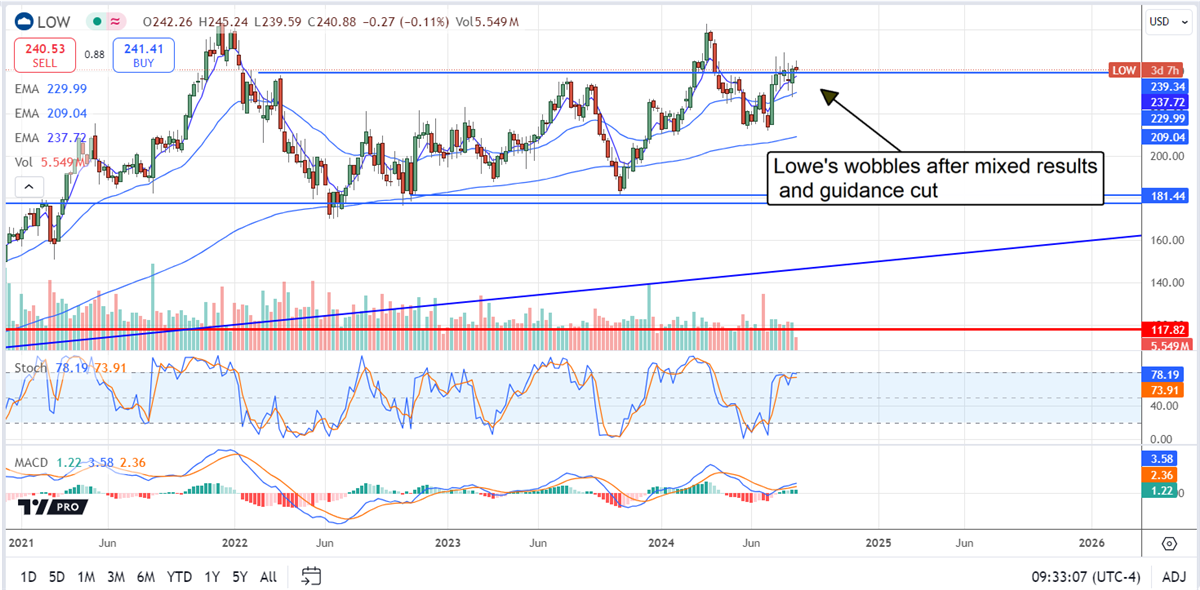Collapse of the Petrodollar (From Colonial Metals)
Written by Thomas Hughes

Lowe’s Companies (NYSE: LOW) stock is in a holding pattern after the Q2 results revealed operational quality offset by a weakened sales outlook. The critical takeaway is that macroeconomic conditions impact sales while operational quality improves. As bad as the guidance seems, it’s not as bad as was feared, and the company is set up to gain leverage when the economy rebounds. Among the critical details are improving sales in the Pro segment, the company’s primary growth avenue today, and solid cash flows that can sustain the capital return program. The only truly bad detail in the report is that share repurchases have slowed and will likely remain weak until business improves systemwide. Until then, investors can bank on the dividend, which trades at a premium relative to historical norms. Trading at 20x earnings, Lowe’s is a value compared to the 10-year average 22.5x P/E multiple and its largest competitor, Home Depot (NYSE: HD), which trades at an even higher multiple. Lowe’s Reports Mixed Results, Cuts Guidance Lowe’s reported mixed results for Q2, impacted by slowing DIY sales, big-ticket item sales, and weather, offset to a small degree by improving Pro sales. The company reported $23.59 billion in net revenue, which is down 5.5% compared to last year and 160 basis points shy of the consensus. Comps are down -5.1%, offset by an increased store count, with DIY sales down nearly double digits and Pro up mid-single-digits. Margin news is also mixed, with margin contraction at every level but less than analysts forecast. The gross margin contracted by 20 basis points, SG&A increased by 50 basis points, the operating income margin increased by 100 basis points, and the net income margin increased by 50. The salient detail is that the $4.10 adjusted EPS is down 10% YoY but outpaced consensus by a dime, providing sufficient cash flow to sustain share repurchases, dividends, and balance sheet improvements. Guidance will move the market over the next few days and weeks. The company lowered its guidance significantly, putting the new high-end range below the prior low-end range, but based on the market response, investors were expecting much worse. Lowe’s Capital Returns Are Safe: Repurchases Slowed in Q2 Lowe’s results drove sufficient cash flow to sustain the capital return, but a problem will undercut the upside share price potential over the next quarter. The company’s repurchases slowed by 60% to only $1 billion in Q2 and will likely remain muted until business picks up again. Repurchases in Q2 helped reduce the count by 2.5% on average for the quarter, a pace investors should expect to slow in the fiscal year’s second half. The dividend remains safe despite the slowdown in repurchases. It is worth about 1.9%, with shares trading near $240, and is less than 40% of the renewed guidance. Distribution increases are also likely to continue, but, as with the repurchases, investors should expect the pace of growth to slow over the next two quarters. Analysts Hold Lowe’s but View its Stock as Fairly Valued The initial analysts' response to Lowe’s results is favorable. The few revisions issued immediately after the report reiterate ratings and price targets aligning with the Hold consensus and the $250 price target. The caveat is that the consensus price target assumes the stock is fairly valued at the current price point and is unlikely to move higher soon. The risk for investors is that the consensus will falter over the coming weeks, adding downward pressure to the market. The price action is bearish going into the open following the release. The market is down about 1% but still above critical support, so the downside may be limited. Critical support is near $240 and may hold despite the weak report. In that scenario, investors should expect to see this market trend sideways until more news is out, including updates on inflation and the outlook for FOMC rate cuts. If the market falls below $240 and can not rebound quickly, it could revert to its trading range with a chance of moving to $215 or lower. 
If you've struggled to gain consistency in your own trading…
It's NOT because you're a bad trader.
You just need a more practical, data-driven approach…
One that helps give you a clear and structured framework for entering and exiting your trades.
And Apollo does just that. Click Here to Experience the Future of Trading.
Written by Ryan Hasson

Investors eagerly await Berkshire Hathaway's (NYSE: BRK.B) 13F filing every quarter, unveiling Warren Buffett's latest stock moves. This event is closely watched as it offers a rare glimpse into the strategies of one of the greatest investors of all time. Among the most recent highlights from the second quarter of 2024 is Berkshire's increased stake in Occidental Petroleum (NYSE: OXY), which has been a significant part of Buffett's portfolio for the past few years. Buffett's History with Occidental Petroleum Buffett's involvement with OXY began nearly four years ago when Berkshire funded Occidental's acquisition of Anadarko with a $10 billion equity investment. About two years ago, as oil prices surged following Russia's invasion of Ukraine, Buffett began purchasing shares in Occidental. Buffett mentioned that his decision to start buying Occidental shares came after thoroughly reviewing the company's earnings call transcript. "I went through every detail and realized this is exactly how I would run things," he said, praising CEO Vicki Hollub for steering the company in the right direction. At Berkshire's annual meeting in May last year, Buffett expressed confidence in OXY's management, stating, "We're not going to buy control," emphasizing trust in the company's leadership. In the latest 13F filing, Berkshire reported buying 7.2 million more shares of Occidental Petroleum, bringing its total stake to around 255 million shares valued at nearly $16 billion, representing 5.7% of Berkshire's total portfolio. Should You Buy OXY Too? Analysts remain cautiously optimistic about Occidental. Based on 15 ratings, the stock holds a consensus Hold rating, unchanged over the past year. However, with a consensus price target of $71.94, analysts see over 25% upside potential for OXY. Since Buffett first started purchasing shares in March 2022, OXY has seen its stock rise nearly 50%, outpacing the S&P 500's 24% gain in the same period. However, in 2024, OXY has underperformed, with shares down 3.89% year-to-date, compared to the S&P 500's nearly 18% gain. Despite this, OXY's fundamentals remain compelling. Its 1.52% dividend yield, attractive P/E ratio of 15.78, and consistent buying by Berkshire make it a potential buy for long-term value and income-focused investors. OXY's Earnings Beat and a Strengthening Balance Sheet Occidental's recent earnings report on August 7th, 2024, further solidifies its strong performance. The company reported earnings per share of $1.03, beating the consensus estimate by $0.26, and revenue was up 2.2% yearly to $6.88 billion. Its key profitability metrics compare well to those of its competition, and another one of Buffett's long-term focuses is Chevron (NYSE: CVX). Occidental's net margin is 16.6% compared to Chevron's 9.31%. Return on equity is 17.91% for OXY versus Chevron's 13.7%. On August 19th, Occidental announced significant progress in its debt reduction efforts, achieving $3 billion in principal debt reduction in the third quarter of 2024. This success was fueled by solid cash flow from operations and proceeds from divestitures, including $700 million raised from a public offering of Western Midstream Partners' common units. With an expected total debt reduction of over $3.8 billion by the end of the third quarter, Occidental is on track to meet nearly 85% of its $4.5 billion debt reduction goal, strengthening its balance sheet and enhancing shareholder returns. Buffett’s Faith in Occidental: What It Means for Investors Buffett's continued investment in Occidental Petroleum underscores his confidence in the company's long-term potential, foundation, and management team. While analysts maintain a Hold rating, the stock's significant upside potential, solid fundamentals, and competent management make it a compelling option for investors seeking value and income in the energy sector. As always, conducting your own research and considering your investment goals before following in the footsteps of the Oracle of Omaha is crucial. If you've missed out on NVIDIA's recent 1,600% run...
Don't worry.
Because there's one AI stock that could be a lot more lucrative. Get the ticker here >>>
Written by Gabriel Osorio-Mazilli

Most of the stock market had thought of the technology sector as a place to be in the past, and that is just not the case today, as names like Palo Alto Networks Inc. (NASDAQ: PANW) show strengthening financial and price momentum as the company’s latest quarterly earnings results are released to the public. While it may not be as attractive a name as some of the previous darlings in the semiconductor industry, this stock is still worth taking a look at. Still a valid player in artificial intelligence, Palo Alto rides on the tailwind of the need for cybersecurity, as even the World Economic Forum (WEF) has warned that cyber-attacks should be more of a concern for every CEO this year and going into 2025. The last time precautions like these were recommended, it had to do with healthcare before COVID-19. Cyber attacks have been on the rise lately. Even Palo Alto’s investor presentation points to a multi-billion impact on companies suffering from such attacks, creating increased demand for the type of services that Palo Alto offers. This is why, even after a recent selloff in the S&P 500, some analysts still expect to see double-digit upside from Palo Alto stock in the coming quarters. Palo Alto Networks Stock Shows Strong and Accelerating Growth Starting with the key performance indicator (KPI) that any software company like Palo Alto Networks wants to see, annual recurring revenue (ARR) reached $4.2 billion in the past quarter, representing a jump of over 43% in the past 12 months. Most competitors in the cybersecurity space can't say likewise. After an incident that caused several headaches (and millions of dollars) to customers, shares of CrowdStrike Holdings Inc. (NASDAQ: CRWD) have yet to recover from the recent dip, selling off by more than 43% in a couple of weeks. Events like these get investor eyes – and capital – turning to the safer names in the space, and that's where Palo Alto Networks stock came to shine. Apart from reporting no incidents and double-digit revenue growth, Palo Alto also showcased a 3.2% expansion in its operating margins. This effort led to a 5% bump in earnings per share (EPS) for investors to enjoy. More importantly, for the future growth of the company's capital, creating the compounding effects that come with free cash flow. Calculated as operating cash flows minus capital expenditures, Palo Alto Networks reported up to $3.12 billion in free cash flow, representing up to 17% growth over the past 12 months. Along with the recurring revenue growth, driving these growth metrics is the over 30% growth in annual contract value from new business. But here's where investors excited about artificial intelligence can take home the cake. Palo Alto Networks reported that artificial intelligence's annual recurring revenue rose four times over the year, reaching over $200 million in contracted value. Wall Street Optimism Drives Analyst Upgrades for Palo Alto Networks Stock Analysts at Scotiabank and Citigroup have something in common other than covering Palo Alto Networks stock as a buy and outperform rating. These analysts landed on a valuation of up to $385 a share for the stock, daring it to rally by as much as 12.1% from where it trades today. Following the bullish trend, Legal & General Group Plc (Palo Alto’s largest shareholder) decided to boost their stake in the company by 8.5% as of August 2024, bringing their net investment up to $1.1 billion today. But these Wall Street players weren’t the only ones willing to risk their capital to express their optimism for Palo Alto Networks stock. Nancy Pelosi, a member of the U.S. government, has also reportedly held this stock since the first quarter of 2024. All of this bullish evidence sent the bears running away. Palo Alto Networks stock’s short interest has been on the decline since the fourth quarter of 2023 and surprisingly failed to rise during the S&P 500 selloff caused by the so-called “carry trade” unwinding between the U.S. dollar and the Japanese yen. There is also one final check investors can go through when gauging how the market may feel about a stock, and that’s done through valuation multiples compared to the rest of the industry. Palo Alto Networks stock trades at a price-to-book (P/B) value of 60.6x today, significantly higher than the computer sector’s average valuation of 6.7x. Markets typically have a reason to overpay for one stock among their peer group, and double-to-triple-digit growth rates alongside increased profitability in Palo Alto Networks might be the foundation for the current sentiment. This key unlocks a new pathway to wealth that has been kept hidden from you for decades.
In my new documentary I will provide you with all the details of this one-of-a-kind investment. Let me explain in this new documentary video
Looking for More Stock Ideas? |